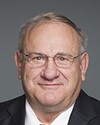Thank you, Ed, and thank you, Madam Chair, and honourable members.
I'm going to continue the remarks by saying the Northeast Region Community Awareness Emergency Response— a mouthful, but it's also known as NRCAER for those of us who know it well—is a mutual aid, emergency response association with a 25-year history of collaborating for safe, informed, and prepared communities. Their members include 30 local industries and eight municipalities, which form a best-practice network of emergency management professionals. They are the organization that coordinates and executes emergency planning and protocols in Alberta's industrial heartland. The organization is represented today by the chair, and Strathcona County fire chief, Iain Bushell, and by executive director, Brenda Gheran, both of whom should be considered Canadian experts in emergency preparedness.
Thank you for coming here today.
Also participating today, as you know, via video is our Fort Air Partnership executive director, Nadine Blaney. The Fort Air Partnership, or FAP to those of us who know it well, is an independent, multistakeholder, air monitoring organization, or airshed, that monitors air quality in and around Alberta's industrial heartland. This organization is a collaborative effort between provincial, federal, and municipal governments, industry, and communities. It is a model to emulate.
Fort Air Partnership collects the air quality data required to calculate the air quality health index. This data is also used to compare provincial and federal air quality standards, including the recently implemented Canadian ambient air quality standards. Fort Air Partnership works closely with the Alberta provincial government and other airsheds in Alberta to implement regional monitoring to inform cumulative effects management of air quality. We should be proud of it as Canadians.
Directly related to the Canadian Environmental Protection Act, the Fort Air Partnership completed a volatile organic compounds monitoring project in collaboration with Environment Canada in 2006. The Fort Air Partnership has also initiated a volatile organic compounds speciation study in a community within our heartland and will be initiating a fine particulate matter speciation study in 2017, both of which are expected to be completed, and results shared with the government and public, in the next three years. The details of these studies can be provided to this committee as a follow-up to this presentation.
Both Northeast Region Community Awareness Emergency Response—and I'm going to refer to that as NRCAER—and our FAP activities are impacted by the Canadian Environmental Protection Act, making their inclusion today beneficial to your deliberations. It is our hope that you will engage them directly in the questions after our overview remarks.
Environmental stewardship, emergency preparedness, air quality monitoring, municipal co-operation, and direct communication with residents regarding their health and safety as it relates to industrial development in our region, are all vital activities through the Alberta industrial heartland and its communities.
Let me tell you a little bit more about who we are, how environmental legislation, including this act and the processes it outlines, impact collaboration in our region, and how changes to the legislation that are intended to improve the health of Canadians can have unintended consequences.
Alberta's Industrial Heartland Association is a municipal not-for-profit organization focused on attracting and retaining sustainable industrial development in a specialized industrial region encompassing eight municipalities and covering over 582 square kilometres of land. This region is known as Alberta's industrial heartland. Membership is comprised of five regional municipalities: the City of Edmonton, the City of Fort Saskatchewan, Strathcona County, Sturgeon County, and Lamont County.
In addition, Alberta's Industrial Heartland Association has three associate municipal members, including the Town of Redwater, the Town of Bruderheim, and the Town of Gibbons. Collectively, our membership represents over 1.2 million residents. It is not insignificant.
For the past 18 years, our association has taken a proactive and co-operative approach to planning for industrial developments in the region. A leading principle of our association is promoting responsible, sustainable development within the region. This requires collaborative regional planning for infrastructure, services, emergency preparedness, and land use that is guided by the principles of environmental stewardship, sustainable community growth, and economic prosperity.
Our association is a model of collaboration, partnership, and synergistic operations that balance protection of our environment with sustainable resource and community development. We encourage public policy frameworks, like this act, that contribute to attainment of these goals.
Alberta's industrial heartland is Canada's largest hydrocarbon processing region and western Canada's energy hub. It is home to a synergistic industrial cluster encompassing over 40 companies that represent investment worth over $30 billion in energy and petrochemical processing facilities. Companies operating in the industrial heartland representing mid- and downstream sectors provide 6,500 full-time jobs and an additional 23,000 indirect jobs, and account for $1.5 billion annually in local spending, with additional monies in charitable giving directly benefiting our communities. These companies are also engaged directly in air quality monitoring with heartland partners, which is important to our residents and the sustainability of our communities.
In a 2015 poll of 400 residents in the area, nearly three-quarters of the residents in our region said they follow industrial activity closely or somewhat closely. It is important to residents to be informed about the industry and the environment. We do have a not-for-profit initiative called “Life in the Heartland”, which provides information and improves communication with residents about industrial operations and development in Alberta's industrial heartland. It is a partnership of five organizations, including those represented here today, plus the heartland industry association, the Northeast Capital Industry Association.
Industry, municipalities, our air monitoring agency, and emergency response recognize the value of keeping the local community informed. This collaborative effort, formed without regulatory requirement, serves as a best practice model for other regions.
It's also important to residents that the environment is being properly managed to allow for responsible and sustainable industrial growth that does not impede their health or quality of life. When asked to rate the air quality in the region in which they live, almost 60% of the respondents ranked it as excellent or good, while 29% ranked it as average. This means that only 13% ranked air quality below average, which is an indicator of success, given the 40 companies operating. It means that innovation and environmental practices in the region are working.
Today we want to highlight the importance of clarity and certainty of regulation as critical for future investment that helps to build the sustainable thriving communities in which we live and operate. Business investment will be attracted to Canada and regions like ours if regulatory processes, such as those currently outlined by the Canadian Environmental Protection Act, remain clearly defined and consistent in application across jurisdictions and are not at risk of continual change. Due process is important to investors, to our companies, and to our region, and this act provides a fair, effective public policy framework for environmental oversight.
Definitions within the act do need to be clear so that expectations and outcomes of regulatory processes can be clear both to the capital investor and to the public. We also believe that regulation language should take into account—as well as foster—multi-agency collaboration and co-operation. In the case of emergency response, for example, it would be helpful to have clarity and language consistency when defining exercise types and schedules in the act.
While regulation is critical to risk management through the establishment of standards, not all positive actions necessarily result from regulatory requirements. Our heartland is a world-class example of successful collaboration and co-operation among many stakeholders who are motivated by a collective issue: mitigating risk to our environment for the protection of public health. While the act serves a critical function, it should be noted that it has not prescribed all of the efforts spent on environmental monitoring and innovation. If this act becomes too prescriptive and cumbersome because of unnecessary reporting, resources can be stretched, and we risk stifling the innovation and multi-agency collaboration that will move us to improvement.
We also need to consider the unintended consequences of regulatory change. Lack of timely decisions and the threat of changing regulatory frameworks result in an investment community that is tentative to engage in our Albertan and Canadian markets. Regulation change can be well intentioned, but if there's not some certainty on process and timelines and a recognition of that, the reliability of our regulatory framework is jeopardized.
To be clear, we are not advocating for a reduction in appropriate environmental regulations that establish important standards for the protection of our communities and the health of people who reside within them. We need to be clear, however, in the requirements we ask for, the manner in which the data is utilized, and the timeliness of change.
We appreciate the opportunity to be here today, and we look forward to the questions to come.










